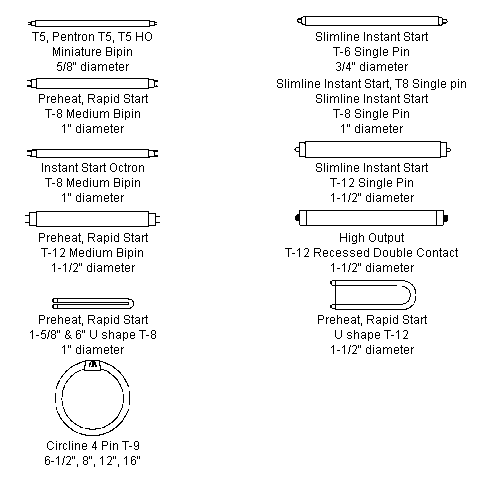Fluorescent Light Technology
Fluorescent Light: A gas-discharge lamp that uses electricity to excite mercury vapor, producing short-wave ultraviolet light that then causes a phosphor to fluoresce, resulting in visible light emission. Fluorescent lights require a ballast to regulate the flow of power through the bulb.
There is phosphor inside the fluorescent light bulb tube that, when excited, converts ultraviolet radiation into visible light. The chemical composition of the phosphor determines the color temperature of the light emitted by the bulb.
Compact Fluorescent Light Bulbs (CFL): A CFL can use less than one-third the electricity of incandescent bulbs of equivalent brightness and last up to nine years. CFLs contain an average of 5 milligrams of mercury, which increases the bulb’s efficiency, posing a new toxic threat to the environment.
Legislation: The Energy Independence and Security Act of 2007 (the “Energy Bill”), signed by the President on December 18, 2007 requires all light bulbs use 30% less energy than today’s incandescent bulbs by 2012 to 2014. The phase-out will start with 100-watt bulbs in January 2012 and end with 40-watt bulbs in January 2014. By 2020, a Tier 2 would become effective which requires all bulbs to be at least 70% more efficient (effectively equal to today’s CFLs). In California, a legislator recently proposed banning the sale of incandescent light bulbs in the state by 2012.
Cold-Weather Ballast: Compact fluorescent light bulbs require a ballast to regulate the voltage of the electricity that is applied to the gas inside the lamp. Below-freezing weather can adversely affect the electronic components in these ballasts, causing most compact fluorescent bulbs to appear dim in cold weather. Cold-weather ballasts compensate for this problem and keep the bulb glowing brightly, even in weather as cold as -10°F (-23°C).
Fluorescent Tube Light Bulbs
T5
The T5 lamp is an increasingly popular development in fluorescent lighting. In 1995, T5 fluorescent lamps entered the market in the United States. Today, the three major lamps manufacturers aggressively market T5 lamps. Luminaire manufacturers create innovatively designed compact luminaires using up-to-date optical materials. Recently, lighting designers have begun to specify such T5 luminaires for high-end new construction. The marketing and innovative design of T5 systems have left many end users wondering whether they should consider T5 luminaires instead of T8 luminaires, especially in new construction and retrofitting of T12 magnetic systems. End users are confused by the 10°C (18°F) difference in optimal temperature and the small difference in system efficacy between T5 and T8 systems. This section focuses on physical characteristics of T5 systems compared to T8 systems. This publication discusses T5 systems—including T5 lamps, ballasts, and luminaires—to answer commonly asked questions.
T5 fluorescent light bulbs are a very small linear type of fluorescent that are used in many applications including under cabinet, task lighting and any place where there is a small space. They are very trim they are only 5/8 of an inch in diameter and have two pins on each end. These shouldn't be confused with the newer version T5 lamps which are out of the market for energy efficiency. These have been on the market for a few decades and are used not for general lighting the specific lighting applications. In other words, you wouldn't use these for overhead lighting, that's the other kind of T5 fluorescent lamp. These come in cool white, warm white and sometimes in the daylight version. T5 fluorescent light bulbs can be identified by the code on the bulb.
T4
Even thinner than the T5 bulb, the T4 bulb have more limited lengths. They are commonly used for under cabinet lighting such as the Westek FA201 which uses a Westek FA200 T4 fluorescent bulb.
